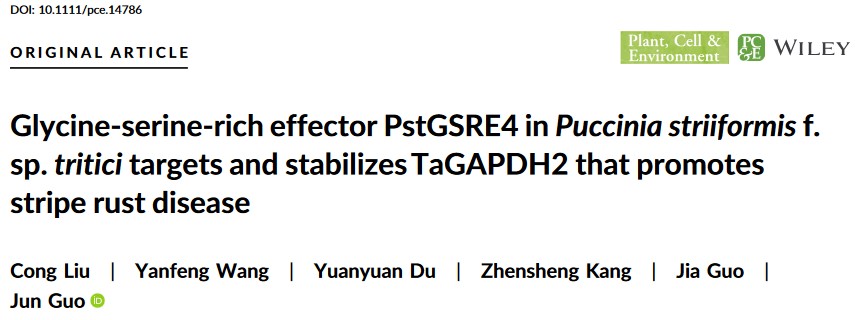Recently, the Plant Immunity Research Team from our college published an article titled "Glycine-serine-rich effector PstGSRE4 in Puccinia striiformis f. sp. tritici targets and stabilizes TaGAPDH2 that promotes stripe rust disease" in the internationally renowned academic journal Plant, Cell & Environment. This study reports a new mechanism of wheat stripe rust fungus regulating plant immunity by the glycine/serine-rich effector, PstGSRE4, hijacking the susceptible factor TaGAPDH2.

Wheat stripe rust, caused by Puccinia striiformis f. sp. tritici (Pst), is a destructive disease in wheat-growing regions of China. As a biotrophic parasitic fungus that survives on living host tissue, stripe rust fungi suppress host defense responses by secreting effectors through their haustoria, thereby promoting pathogen infection. Therefore, revealing the functions of effectors and their immune regulatory mechanisms can help to further understand the pathogenic mechanism of the pathogen and provide theoretical basis for creating durable resistance against stripe rust.
Previous studies found that PstGSRE4 reduces the accumulation of H2O2 induced by pathogen infection by inhibiting the enzymatic activity of copper/zinc superoxide dismutase TaCZSOD2, thereby promoting its own infection (Liu et al., PLoS Pathogens, 202218(7): e1010702). In this study, the immunoprecipitation-mass spectrometry (IP-MS) technique was used to screen and identify the new target of effector PstGSRE4, glyceraldehyde-3-phosphate dehydrogenase TaGAPDH2, and protein interaction technology was used to confirm the interaction between the two proteins. Silencing TaGAPDH2 enhanced resistance to stripe rust in wheat, while overexpression of TaGAPDH2 significantly increased the virulence of stripe rust, indicating that TaGAPDH2 is a susceptible factor for wheat stripe rust. It was further found that TaGAPDH2 can prevent reactive oxygen species (ROS) accumulation and inhibit cell necrosis, while the effector PstGSRE4 can enhance the stability of TaGAPDH2 to promote pathogen infection (figure).

Stripe rust effector PstGSRE4 targets and stabilizes TaGAPDH2 to regulate plant immunity model
This study clarifies that the effector PstGSRE4 of stripe rust targets and stabilizes the susceptible factor TaGAPDH2 in wheat to promote pathogen infection. This study enriches and deepens our understanding of the pathogenic mechanism of biotrophic parasitic fungi and the function of TaGAPDH2 in plant immunity. It also promotes the innovation of wheat resistance to rust disease and provides theoretical basis for sustainable green prevention and control of plant rust diseases.
Professor Guo Jun and Associate Professor Guo Jia are the corresponding authors of this article, and Ph.D students Liu Cong and Wang Yanfeng as the co-first authors. The experimental platform of the National Key Laboratory of Crop Resistance and Efficient Production provided technical support for the completion of this article. This study was supported by the National Key R&D Program (2021YFD1401000), the National Natural Science Foundation of China (32172381 and 31972224), the Support Plan for Innovation Capacity of Shaanxi Province (2023-CX-TD-56), the Key R&D Program of Shaanxi Province (2021ZDLNY01-01), and the 111 Project of Ministry of Education (B0719026).Original link: http://doi.org/10.1111/pce.14786